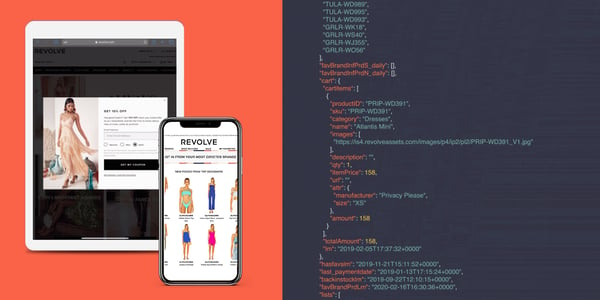August 5, 2020
 by Lauren Ventura / August 5, 2020
by Lauren Ventura / August 5, 2020

There’s been a shift in thinking that many businesses have had to adapt when it comes to their customers.
Consumers are no longer viewed as static, unchanging archetypes, but instead as fluid and ever-evolving. They are active participants in their purchasing journey, selecting offers that fit their changing needs, and opting for products and services that have been designed specifically for them. They demand that every experience be unique, entertaining, engaging, and tailor-made. And it’s up to marketers to listen, react, and deliver these experiences.
The research agrees:
This means that consumers are making purchases from brands that have demonstrated the ability to provide personalized communication – a clear necessity when building loyalty.
In fact, a recent report by Segment notes, “Consumers are expecting personalization more quickly, with 54% of shoppers anticipating a personalized discount in a day, and 32% within just an hour of sharing their information with a retailer.”
Consumer brands are expected to cater to each and every customer – tastes and preferences should be acknowledged, and signals should not be ignored.
Hyper-personalization is gaining traction within the marketing industry, but unlike other fluffy marketing speak, hyper-personalization may have what it takes to withstand the test of time.
In its early days, personalization meant merely using the customer’s name in the subject line and email copy, cart abandonment email programs, or Facebook custom audience ads. But now, so many brands are running these same campaigns and the personalization is beginning to lose its charm. With the amount of data we now have at our fingertips, hyper-personalization has opened a new world of possibilities.
To explain, let’s look at an example of the difference between personalization vs. hyper-personalization: “Personalization may include advertising winter weather gear to consumers who purchased similar gear online the year prior,” Stephanie Mialki of Instapage explains.
“Hyper-personalization, on the other hand, could include advertising that same winter gear with optimized ads based on the exact purchase location and time, payment method, coupons used, social media activity, and more.”
Personalizing online interfaces, tailoring product recommendations, increasing the relevance of shoppers search results, and providing immediate and useful customer service – these new modes of personalization are not only powered by consumer data, but AI. We’ll get into that more as we go on.
Overall, hyper-personalization is important because it represents a clear path forward for brands who are serious about adapting to the empowered, educated consumer. Building on personalization and segmentation, hyper-personalization uses these categorization principles but takes them a giant leap further.
Another important facet to discuss, is that there are two different options when it comes to hyper-personalization ‘recognize me’ and ‘help me’. The difference is subtle. ‘Recognize me’ personalization utilizes data to show that you know who the buyer is, such as tailoring imagery and content, or welcoming the customer by name.
‘Help me,’ on the other hand, “uses data to make the buyer journey easier and faster, reassuring prospects with proof-points to relieve anxiety they may feel about their purchase, as well as directing them to the right place to solve their specific problems, and enabling users to reward them with exclusive offers,” explains Econsultancy.
Going even further, hyper-personalization, like segmentation, is the practice of using data to tailor the customer experience. The major difference now is the volume of data that’s available for use. By definition, the concept of segmentation groups customers into segments is based on broad characteristics and demographics, such as gender, age, or location.
Hyper-segmentation is using this mixture of data to develop niche segmentation conditions for your next email marketing campaign. Instead of organizing customers into broad groups, hyper-personalization turns each customer into a segment of one.
This demographic data is used along with real-time data from a subscriber's action or online interactions such as browsing history, past purchases, videos watched, survey filled, people referred to, and social media posts to create hyper-personalization opportunities.
Historically, marketers have relied on grunt work, pouring over spreadsheets and analytics reports to create their customer segments. Today, there’s simply too much data to review manually. The increase in the amount of data we collectively generate has sparked the development of advanced marketing strategies. Marketers, technologists, and data science teams can analyze millions of data points to identify statistical patterns that can be used to better understand customer behavior.
For instance, let’s say you have a group of loyal customers in your database but they tend to purchase in December and April. With AI-driven data on your side, you can now segment these customers and send them hyper-personalized messages, offers, and promotion in the months before their peak purchase time. If they tend to buy holiday-inspired items in December, use that historical data to optimize their experience with your brand.
More ways to hyper-personalize are to A/B test subject lines for effectiveness, to tap into predictive analytics to uncover your customer’s ideal open time, or to send previously browsed products to their inbox – a heightened version of cart abandonment that has proven effective for brands like Revolve.
“We launched more than 200 automated campaigns. We A/B test every single message, and we’re meeting our goal of having one-to-one personalization in all our messaging,” explains Jennifer Fan, Director of Retention at Revolve.
With the addition of those automated campaigns using hyper-personalized messaging, Revolve increased their revenue per delivery by an average of eight times (equivalent to a projected $11.7 million annual revenue), in just eight months.

And let’s not forget the ultimate example in hypersonalization: Amazon.
Forbes’ Lilach Bullock perhaps sums it up best when she writes, “When it comes to behavioral targeting, predictive modelling and personalization, Amazon is number one. With the incredible amount of data at their disposal, is it any wonder? [...] From personalized onsite content to personalized emails and offers, the company delivers dynamic, data-powered messaging in real-time.”
Amazon pulls every personalization lever imaginable. Let’s face it: they know when you run out of toilet paper. They send you a targeted reminder or would-you-like-to-add-this-to-your order prompt. Both are intimate recommendations based on your behavioral data. Every click, every browse action, even a hover, registers with Amazon’s hyper-personalized algorithms.
SmarterHQ studied the Amazon phenomenon, and reported, “McKinsey & Company found that 35% of consumers' purchases on Amazon come directly from the e-commerce platform’s unique ability to provide similar product views, powered by algorithms and predictive modeling.”
Lastly, an almost futuristic example of hyper-personalization can be found at the Westfield shopping complex in Shepherd's Bush, London. And according to analysis by Social Media Today, “The complex now has cameras in and around the mall which use facial recognition technology to determine the age, sex, and even the mood of the shoppers as they move through the buildings. Based on what the system learns, it can then display different ads on the various digital billboards around the mall in order to maximize consumer response.”
Those millions of data points, collected in real-time from every customer interaction, are the foundation of hyper-personalization – and it goes way beyond simple demographics. Brands that are serious about the customer experience are crunching data from website cookies, social profiles, advertising platforms, in-store and online transactions, mobile apps, and other connected devices.
They then use this data to ensure that every single brand experience reinforces their commitment to the consumer. Furthermore, marketing teams are using this real-time data to connect customer experiences across channels to create a fluid buying experience that can flex and evolve with each new interaction.
One important note is that hyper-personalization is not a state of nirvana that can be achieved overnight. It is a process that happens gradually as you collect and activate data and use it to create more sophisticated campaigns, touchpoints, and interactions with your customers. The keys to success lie within a platform that can unlock your data and a sustainable and scalable process.
Your marketing platform is the tool that will enable you to pull together a coherent hyper-personalization strategy. A survey of 200 marketing leaders by Forbes Insights and Arm Treasure Data revealed that when personalization is utilized in enterprise business models, they see positive results.
Here are some interesting statistics from the survey:
And the key to effective hyper-personalization is data. Lots and lots of data. A limitation for many marketers is that their customer data is locked up in data silos controlled by various marketing tools. Your platform absolutely must be able to unlock and activate this customer data in real-time.
Platforms unify data from anywhere in your marketing stack – things like page views, app opens, clicks, cart abandonments, purchases. Interruptions to a fluid customer experience is often the result of siloed, disconnected data. The first step toward hyper-personalization is to choose a platform that can pull all available customer data into any message type: email, SMS, push notifications, in-app messages – to provide content that’s individualized for each consumer.
Remember at the beginning of this post we noted that customers are more likely to purchase from a brand that offers personalized services based on their individual preferences? Well it’s true. With so much competition out there, it’s no wonder reviews are so important in every aspect of our process. So what makes a brand trust-worthy to consumers?
Based on research by Edelman, the top reasons include:
Brands who do a better job at winning trust will also offer clear, easy-to-understand, use case-driven, instructional or thought-leadership content, especially in video form.
If you truly understand your customer, you can send a better message by understanding them beyond their demographics’ data—you see what they browse, you know they’re waiting for a sale because they typically shop at yours annually, or perhaps they’re part of a loyalty program customized by their purchase behavior.
Seventy-nine percent of consumers are only likely to take advantage of a brand’s offer when it is personalized to reflect the individual’s previous engagements with the brand. So take advantage of all those channels, data, and touchpoints!
Creating a repeatable and scalable process is key to keep pace with changing customer expectations. When considering how to alter internal processes, take into account the speed at which you need to move to make hyper-personalization effective.
Processes should be less about lengthy design cycles and more focused around fast iteration to determine what works and how to replicate it for the largest number of customers. There should also be a healthy amount of experimentation, especially early on, as your team or business adapts to this shift in operations. Finally, make sure to track everything you are doing and build in time to review data. This is a key step that many overlook. If you don’t know what’s not working, how can you improve it?
Consumer expectations have changed, and the companies that can consistently provide personal, meaningful experiences will be the most successful. There’s no reason to fear a shift from segmentation to hyper-personalization – it doesn’t need to happen all at once.
It’s an iterative process that involves steady digital transformation, structured implementation, and perhaps most importantly, access to first-party data. Data is the foundation for personal, relevant, and emotionally intelligent marketing, and once the technology and strategy are in place, hyper-personalization can truly begin.
A former award-winning journalist, Lauren attended UC-San Diego and San Diego State University to master all forms of writing. Since then, she’s worked as a content creator for Road Runner Sports, Competitor Group, Petco, and tons of startups around the world, including Cordial.
The way we travel is changing. We look for flights and hotels differently than we used to, we...
 by Rob Browne
by Rob Browne
As a consultant, you want to stand out by providing every client with personalized advice at...
 by Stefan Debois
by Stefan Debois
Give a little TLC to your brand audience.
 by Ben Johnson
by Ben Johnson
The way we travel is changing. We look for flights and hotels differently than we used to, we...
 by Rob Browne
by Rob Browne
As a consultant, you want to stand out by providing every client with personalized advice at...
 by Stefan Debois
by Stefan Debois


